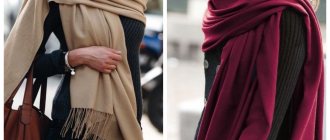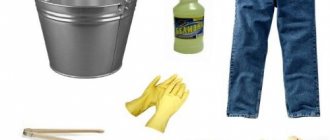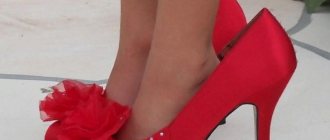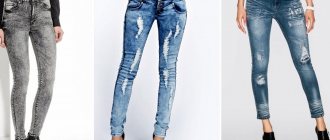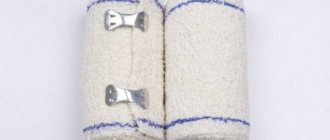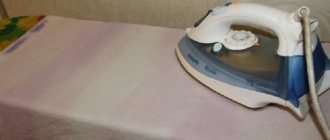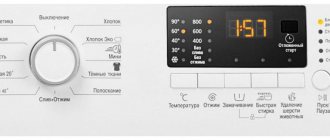Compression hosiery is one of the main means in the treatment of chronic venous insufficiency (“varicose veins”). It is made from materials with clearly defined characteristics, which are necessary to ensure a therapeutic effect. These materials require compliance with certain care and handling rules. Their implementation will ensure an appropriate service life and prevent damage to the product.
Take care of anti-varicose jersey, and then it will help preserve the beauty and health of your legs!
Functions of compression garments
This type of clothing is prescribed for preventive and therapeutic purposes. Each of the venous diseases is associated with significant expansion of the veins.
The principle of operation of a compression product is based on the difference in pressure created across the limbs. The shin accounts for an average of 70% of the pressure, and the thigh about 30%. The veins contract, blood is pushed out, and blood flow stabilizes.
Externally created compression using properly selected knitwear gently and gradually compresses the venous walls. This allows:
- improve the quality of blood circulation in the body’s vascular system;
- normalize blood flow, and with it blood pressure;
- reduce blood viscosity;
- gradually reduce the diameter of blood vessels;
- improve tissue nutrition in the body;
- reduce the risk of blood clots;
- reduce external manifestations in the form of venous networks, “stars”;
- eliminate swelling and pain.
That is, compression knitwear allows the veins not to expand due to their own elasticity and the pressure created on the body.
What are compression garments and why are they needed?
Compression stockings belong to the group of therapeutic and prophylactic products that are made from special innovative materials that provide an anti-embolic effect. Before the advent of stockings, compression was achieved through the use of elastic bandages. Unlike the latter, compression stockings, which can be bought today in almost any specialized store, have significant advantages, practicality in use and a longer service life.
Compression stockings are needed to provide support to weakened veins and muscles. Due to graduated compression technology, compression products increase blood outflow and normalize general blood circulation, preventing the formation of blood clots.
The advantages of compression stockings are as follows:
- High-quality support for venous and vascular walls;
- Activation of blood circulation in the lower extremities;
- Prevention of further expansion of veins;
- Support muscle tone and soft tissue;
- Reducing pain, heaviness and fatigue in the legs;
- Prevention of cramps in the calf muscles;
- Treatment and prevention of spider veins.
In what cases are compression garments necessary?
These products are prescribed by specialists in cases of identified problems with the condition of the veins. Depending on the complexity of the situation, a specific type and class of compression equipment is assigned.
- Venous diseases: thrombophlebitis, varicose veins, thrombosis, lymphedema. The stages of these ailments require wearing elastic underwear with a compression effect to minimize the risk of developing vein thrombosis and improve the patient’s overall well-being.
- Use in the postoperative period allows for faster recovery. Despite bed rest, the patient will receive active blood circulation in the vessels due to external pressure from the elasticity of the underwear.
- During pregnancy, compression hosiery normalizes pressure in the lower extremities, improving blood flow. Heaviness in the legs, swelling disappears and the blue veins disappear almost completely.
- During the postpartum period, compression keeps the abdominal muscles toned, prevents prolapse of the internal organs and allows the mother to quickly return to physical shape.
- During sports training, the level of body fatigue is reduced, and pain syndrome is prevented during unusual or heavy loads.
- To maintain optimal well-being during long flights or during sedentary work, you should use stockings or tights for preventive purposes.
- Compression is also used in the field of dietetics as an additional tool for losing weight and removing excess fluid. Stockings and tights stimulate the reduction of fat deposits, smooth out the skin texture through micromassage and toning of the upper layers of the skin.
Are there any contraindications?
Compression hosiery is not a panacea for all vascular diseases. Therefore, when selecting products, it is important to provide the specialist with comprehensive information about your concomitant diseases.
Wearing compression products is prohibited in the presence of chronic arterial diseases, which are accompanied by a narrowing of the lumen of blood vessels. These are atherosclerosis, aortoarteritis, Raynaud's syndrome, polyneuropathy. Also, use for diabetic foot, trophic ulcers, and osteoarthritis is not allowed.
Relative factors for a wear ban are:
- tissue trophic disorders and dermatological diseases of a microbial nature;
- open wounds, bedsores, eczema;
- increased skin sensitivity;
- diabetes;
- deterioration of blood circulation due to heart or pulmonary failure.
What are compression stockings for?
This knitwear improves blood circulation in the legs. As a result, pain and swelling that bother many people are reduced. Underwear also helps against more serious diseases, for example, they reduce the risk of deep vein thrombosis and the likelihood of blood clots.
Elastic stockings for varicose veins are made of a special material that stretches well and fits the leg. Knitwear gently compresses the veins. Typically, underwear puts the most pressure on the ankles, with less pressure up the leg.
Doctors prescribe compression stockings for different purposes:
- Vein support
- Prevention of blood accumulation
- Prevention of trophic ulcers
- Combating venous hypertension
- Improved lymphatic drainage
When knitwear puts pressure on blood vessels, it has several positive effects:
- Reduces vein diameter
Blood flows faster through narrow vessels. Therefore, it extremely rarely accumulates in one place and blood clots almost never occur.
- Improves blood flow
Thanks to the additional pressure, the blood moves faster and travels faster from the feet to the heart.
- Prevents blood from draining
Despite the force of gravity, blood rarely flows down the veins and does not fill the connecting vessels.
Even some athletes use compression stockings in their training. For example, runners and basketball players. Underwear protects tissues from damage and accelerates the delivery of oxygen to muscles. After training, muscles recover faster.
Of course, compression stockings for varicose veins cannot be considered a magical artifact that will save you from any problems with blood vessels. Unfortunately, it is not. Like other medical products, compression stockings are not suitable for everyone.
Types of compression garments
Before wearing compression hosiery , you need to navigate the current range of models.
Most manufacturers make products from microfiber, nylon, lycra or cotton threads. The machines allow you to create a circular seamless weave that provides comfort while wearing. The elastic component is located inside the product, in a braid of fibers.
- Tights - tightly fit the legs, fit at waist level. Due to the soft belts and high elasticity of the material, they do not slip during wear. Help prevent the development of hemorrhoids. Externally, the product is no different from ordinary nylon tights.
- Stockings are a more practical option for use, requiring some skill and practice when putting them on. The stocking is very tight and dense; it requires some effort to pull it evenly over the limb. Cuffs can be universal for men and women, or with lace inserts.
- Knee socks are compact and comfortable, not visible from under clothes. Can be shortened or standard height. The elastic band is located below the knee. Unisex style product. The reinforced heel reduces pressure on the feet during active activities. The toe can be open or closed. Some brands have Velcro or zipper options for ease of putting on.
- Socks are often used by men at the initial stage of development of vein diseases. They look laconic, fit comfortably on the shin due to the thick elastic band and are made in various shades.
7 recommendations for choosing
Want to know how to wear compression stockings ? We advise you to first decide on the correct selection of products. This is influenced by a number of factors.
- Decide on the purpose of use: prevention, treatment or in the postoperative period.
- Visit a doctor to select the desired height of the product: tights, stockings, knee socks, socks.
- Buy compression boots strictly according to the required compression class.
- Choose the size based on the table indicated on the manufacturer's packaging. Before visiting the store in the morning, take measurements of the half-girth of the limbs: in the lower leg area, under the knee, in the middle of the thigh, under the buttock.
- When choosing a brand, pay attention to brands with a reputation as a reliable manufacturer who has been in this field for a long time.
- Take a closer look at the quality of tailoring: there should be no pronounced seams or joints, the material should look uniform in texture and color, and have excellent stretch.
- The final cost of the product depends on the quality of the materials used, innovative production techniques and international certification.
Jersey compression: 4 degrees for your health
Before putting on and wearing compression hosiery , it is important to determine the degree of compression pressure. It varies according to the severity of the disease and numerous individual factors.
Compression for prevention
Provides pressure within the range of 14-19 mmHg. Used for excess weight, cellulite manifestations, long flights and trips.
- relieves swelling in the calf muscles;
- relieves pain;
- Gives the skin a uniform, pleasant shade and texture.
1 class
It is actively used if there is a predisposition to varicose veins and the first obvious signs of varicose veins. Provides uniform pressure in the range of 19-23 mmHg.
Indications for wearing:
- visually noticeable bulge of the wreath;
- feeling of bursting heaviness in the evening;
- prolonged standing or sitting position, which is accompanied by pain;
- burning sensation in the calves.
Regular wearing of compression garments allows you to immediately eliminate the main symptoms and consolidate the effect.
2nd grade
It is used for obvious manifestations of varicose veins with a progressive perspective. Provides pressure of 24-33 mmHg. Used for bulging and obvious veins over 5 cm in length, the presence of pronounced nodes, cramps and swelling of the lower extremities. Also used after surgery.
3rd grade
Thrombosed veins with great depth and insufficiency of venous blood flow require wearing reinforced knitwear with a pressure of 35-47 mmHg. Relieves postthrombotic syndrome, large-scale swelling and trophic changes.
4th grade
The products exert strong pressure of more than 50 mmHg. and requires special equipment to put it on. Use is strictly under medical supervision. Used for lymphedema.
recommended products
Anti-varicose tights, compression class 1, 18-22 mm Hg.
Anti-varicose tights, compression class 2, 23-32 mm Hg.
Anti-varicose stockings, compression class 1, 18-22 mm Hg.
Anti-varicose stockings, compression class 2, 30 mm Hg.
Anti-varicose socks, compression class 1, 18-22 mm Hg
Anti-varicose socks, compression class 2, 30 mm Hg
Anti-embolic stockings (compression class 2), 25 mm Hg.
Device for putting on compression stockings
Men's anti-varicose knee socks, compression class 1 (18-22 mm Hg)
Men's anti-varicose knee socks with open toe, compression class 2 (23-32 mm Hg)
Men's compression stockings 1 class. 4214 ORTO
Wearing knitwear correctly
How to put on compression hosiery quickly and with maximum comfort? To do this, follow the general rules:
- remove all accessories, as well as watches, from your fingers;
- cut your nails short and file them with a nail file;
- feet and legs should also be put in order: get rid of calluses, corns, and other roughness;
- the process should go slowly and carefully, with uniform distribution along the leg;
- Wear elastic underwear in the morning, before your feet are swollen. Or sit with your limbs elevated for 10 minutes to reduce swelling;
- your body, hand skin and products must be completely dry;
- If the degree of compression is high or you lack donning skills, then use additional devices.
How to put on and wear compression stockings correctly
First of all, put on elastic underwear immediately when you get up. Without even getting out of bed.
Raise your leg. It should be above the level of the heart - in this position the pressure in the vessels decreases. Carefully slide your foot inside and slowly pull the fabric up.
Smooth out your stockings. They should fit snugly to the skin. Smooth out the folds. The top of the underwear should not be folded down, otherwise the knitwear will press like a tourniquet, and as a result, blood circulation will be impaired.
It is not recommended to remove compression stockings during the day. Only in the shower or bath. Before going to bed, lie on your bed and elevate your legs. Then take off your underwear.
How long should knitwear be worn?
Ask your doctor. Mild forms of varicose veins can be eliminated in a few months, but chronic diseases are a more serious problem. Sometimes phlebologists recommend that patients wear elastic stockings for several years. In rare cases - all your life.
If treated carelessly, knitwear will not last even a few months. Therefore, it is necessary to properly care for it.
How to put on stockings, tights, stockings or socks?
All therapeutic and prophylactic products in this range are put on in a similar way without additional tools.
- Remove from packaging and carefully straighten.
- Place your hands, clenched into fists, into the stocking and grab the heel area.
- Turn inside out, without letting go of the toe part, check for wrinkles.
- Insert your foot into the “pocket” that has formed. The heels of the jersey and the wearer should match without twisting.
- Carefully grasp the fabric a couple of centimeters from the ankle and pull upward.
- Grabbing 5 cm at a time, move higher up the leg, tightening the compression garment.
- Smooth the surface so that there are no wrinkles anywhere.
If your tights have an open toe, you should use the special silk socks that come with the kit.
In the case of low socks and knee socks, you can cope without additional devices.
Where to buy anti-embolic stockings?
You can buy anti-embolic stockings in Ukraine in the specialized chain of stores ORTO SMART - Medtekhnika, orthosalon. Why do we not recommend purchasing such products in pharmacies? First of all, because those products that are offered to you in non-specialized stores may not meet quality standards, and, therefore, will not have the necessary therapeutic and prophylactic effect. We want your costs to be justified, so we are ready to provide you with all quality certificates that confirm the effectiveness of the products we offer.
You can always buy Copper, Aurafix or Belsana stockings on the website of our online store Orthosalon. We provide a wide range of products, a rich color palette and affordable prices.
Special devices to make donning easier
Do you want to know how to make wearing and dressing compression hosiery ? Use one of the popular devices.
Spray
Cares for the skin, moisturizes it and relieves pain during the first stages of use.
- Shake the bottle so that the emulsion is homogeneous.
- Turn the compression stocking inside out.
- Spray the liquid at a distance of 25 cm.
- Repeat the procedure before each dressing.
Gloves
Choose medical gloves strictly according to the size of your palm. They should have a slightly rough surface. Gently lift the jersey with your fingers and begin to gradually distribute it along the entire length of the leg. Due to the increased grip between gloves and compression garments, the latter will slide much easier.
Butler
The device is used by patients who have difficulty bending over or have difficulty reaching their feet. There are specimens with standard and extended handles, collapsible and stationary for bedridden patients.
The device has a design of several arcs with durable bases. Made of metal.
How to wear compression hosiery using Butler?
- The product is lowered with its toe down between two arches.
- The elastic band is carefully pulled over the arches and the stocking is lowered to the very base.
- Pull the stocking until the heel area is at the top of the device.
- Gradually place the stretched sock on your foot, moving the butler higher and higher on your leg.
- Carefully remove the device, leaving the underwear on the limb.
- Use gloved hands to smooth out possible wrinkles.
Process features for products with silicone rubber
When washing products with silicone rubber, you should consider the following nuances:
- Silicone can lose its elasticity from water and detergents, so these stockings can only be washed by hand.
- To prevent water from rising up the silicone through the fibers, its path must be blocked. To do this, pull the stocking tightly with a simple elastic band under the very edge of the silicone insert.
- Then do normal hand washing.
To maintain anti-slip properties, it is advisable not to wet the silicone strip. It can be cleaned periodically using a cotton swab dipped in a solution of rubbing alcohol.
How long can you wear?
The duration of wear is determined strictly by the doctor who prescribed the use of compression hosiery.
In the initial stages of venous diseases, stockings are used for 3-4 months. If the situation is serious, lifelong wear may be needed. In the postoperative period, constant wearing is also ensured for 7-14 days.
The daily duration of wearing should not be less than 5-7 hours.
Most often, compression products are removed at night on the recommendation of the treating specialist.
Anti-varicose stockings for pregnant women
During pregnancy, taking care of yourself and your health for the expectant mother comes to the fore. The safest way to stop the progressive development of the disease is to use anti-varicose jersey.
In the third trimester, the maximum load falls on the ankle and lower leg. Anti-varicose stockings, both during childbirth and pregnancy, can provide maximum compression to these areas.
However, before buying anti-varicose stockings, you should carefully read the tips on choosing compression stockings.
How to remove compression stockings?
We figured out how to wear compression hosiery . It's time to familiarize yourself with the method of removing it.
- Remove jewelry from your fingers and put gloves on your hands.
- Sit or lie down.
- Raise your leg so that you can reach it comfortably. Grasp the top of the product and gently pull it up to the ankle, avoiding wrinkles.
- Remove the stocking from the rest of your foot by turning it completely inside out.
When removing knitwear, you can also use additional devices such as butlers.
How to care for the products?
Having figured out how to wear and put on compression hosiery , you also need to understand the intricacies of care. Monitoring the condition of compression products will allow them to last much longer.
- Cleaning is carried out as the knitwear becomes dirty. Delicate hand washing is allowed at a temperature not exceeding 30C. Use a slightly alkaline shampoo as a detergent.
- After removing dirt, rinse the stockings in warm water and wrap them in a towel and wring them out lightly.
- Dry in a room with cool air. Stockings should lie horizontally on a towel.
- Do not dry the product in direct sunlight or near heaters.
- If your stockings have silicone stripes, keep them away from water. To clean, wipe the silicone inserts with a cloth soaked in ethyl alcohol.
- Never pull too hard on the top edge when putting it on, as this may damage the weave!
It is most convenient to purchase two pairs of stockings, which will be changed as they get dirty. Average service life is 6-8 months.
And now the bonus promised at the beginning of the article! When placing an order, enter the promotional code “ movement ” and receive a nice discount on your first order!
Caring for compression stockings
The stockings do not look like a durable product. And indeed, usually their service life does not exceed 12 months, and in many cases the linen breaks and becomes unusable even earlier.
What to do?
First of all, stockings need to be washed. Including knitwear with antimicrobial protection. Remember - you wear elastic underwear all day and dead skin cells constantly accumulate on it. So wash it daily.
It's best to do it manually.
For washing, use baby soap or other delicate products that will not damage the knitwear. You cannot boil laundry.
After washing, squeeze the water out of the stockings very carefully. Do not stretch them, otherwise you will damage the fabric. You can remove moisture with a towel.
Dry knitwear on a flat surface only in cool or warm places, as extreme heat can destroy the material.
Even with proper care, stockings will sooner or later lose their elasticity. Sometimes after just a few months. Less often - after a year.
How to change knitwear in time?
The loss of elasticity is easy to notice in the morning when you put on stockings. Old compression garments stretch very easily. Hence the conclusion - it no longer grips the legs with the required strength and therefore it is necessary to buy a replacement.
